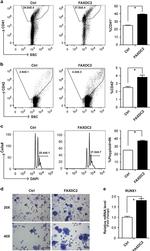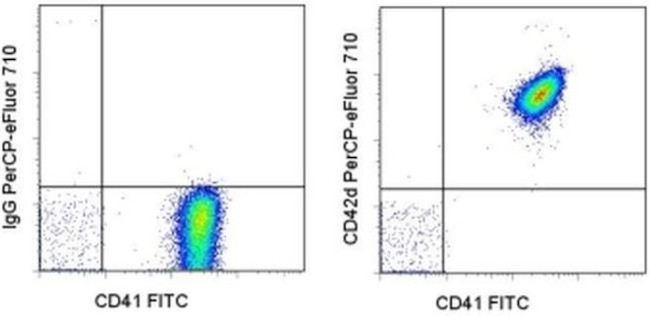Search Thermo Fisher Scientific
Invitrogen
CD42d Monoclonal Antibody (1C2), PerCP-eFluor™ 710, eBioscience™
图: 1 / 3
CD42d Antibody (46-0421-80) in Flow



产品信息
46-0421-80
已发表种属
宿主/亚型
分类
类型
克隆号
偶联物
激发/发射光谱
形式
浓度
保存条件
运输条件
RRID
产品详细信息
Description: The monoclonal antibody 1C2 recognizes mouse and rat CD42d, a single transmembrane protein also known as platelet glycoprotein V (GPV). CD42d interacts with CD42a, CD42b and CD42c to form the receptor for von willebrand factor and thrombin. This functional complex plays a role in platelet adhesion. Expression of CD42d (unlike other markers such as CD41) is restricted to resting platelets and megakaryocytes and therefore is a good marker for development of megakaryocytes.
Applications Reported: This 1C2 antibody has been reported for use in flow cytometric analysis.
Applications Tested: This 1C2 antibody has been tested by flow cytometric analysis of mouse platelets. This can be used at less than or equal to 0.25 µg per test. A test is defined as the amount (µg) of antibody that will stain a cell sample in a final volume of 100 µL. Cell number should be determined empirically but can range from 10^5 to 10^8 cells/test. It is recommended that the antibody be carefully titrated for optimal performance in the assay of interest.
PerCP-eFluor® 710 emits at 710 nm and is excited with the blue laser (488 nm); it can be used in place of PerCP-Cyanine5.5. We recommend using a 710/50 bandpass filter, however, the 695/40 bandpass filter is an acceptable alternative. Please make sure that your instrument is capable of detecting this fluorochrome.
Fixation: Samples can be stored in IC Fixation Buffer (Product # 00-822-49) (100 µL cell sample + 100 µL IC Fixation Buffer) or 1-step Fix/Lyse Solution (Product # 00-5333-54) for up to 3 days in the dark at 4°C with minimal impact on brightness and FRET efficiency/compensation. Some generalizations regarding fluorophore performance after fixation can be made, but clone specific performance should be determined empirically.
Excitation: 488 nm; Emission: 710 nm; Laser: Blue Laser.
Filtration: 0.2 µm post-manufacturing filtered.
靶标信息
Natural killer (NK) cells in teleosts and their evolutionary homologue are a subpopulation of lymphocytes with properties that distinguish them from either B- or T-cells. NK cells are important effectors of innate immunity where they release cytokines, which in turn up-regulate other immunological functions. Monoclonal antibodies have been used to identify different surface antigens present on NK cells. These surface antigens have not only been used to identify NK cells, but also their functionally distinct subsets. The Cluster of Differentiation (CD) nomenclature was established to standardize the naming of NK cells.
仅用于科研。不用于诊断过程。未经明确授权不得转售。
How to use the Panel Builder
Watch the video to learn how to use the Invitrogen Flow Cytometry Panel Builder to build your next flow cytometry panel in 5 easy steps.




